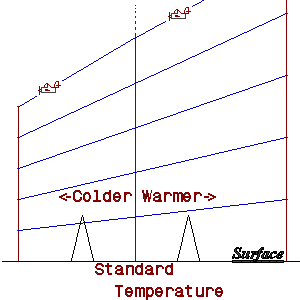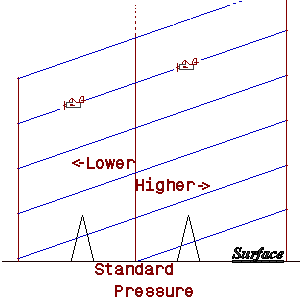
Pilot Courses of Instruction
Flight Instruments
Steve Sconfienza, Ph.D.
Airline Transport Pilot
Flight Instructor: Airplane Single and Multiengine; Instrument Airplane
cell: 518.366.3957
e-mail: docsteve@localnet.com
Altimetry, Airspeed, & Related Information
On a standard day at sea level, calibrated altitude, pressure altitude, true altitude, and density altitude will all be equal.
From High to Low, Look out Below
When flying from areas of high temperature or high pressure, the airplane, with no corrections made, will follow a constant datam plane downward: that is, the altimeter reading a constant altitude, will lead the pilot to correct altitude (in absolute terms) downward (see figure one). Altitude errors of as much as 20% have been estimated (see IFR Exam-O-Grams).
When flying from an area of high pressure to low pressure, the effect of following a standard datum is negated by using enroute altimeter settings.
There is no practical way of directly reading altitude corrected for temperature, so following a constant indicated altitude can cause aircraft to come dangerously close to the ground or other obstructions enroute.
NOTE: Obstacle altitudes on charts are in true altitude.


(*)
Compressibility is a higher altitude, higher speed phenomenon. Compression becomes a factor over about 10,000 feet and 200 knots. See a typical Compressibility Correction Chart.
The pitot-static system has two aspects that are open to the outside of the aircraft: the pitot tube, which measures the ram-air pressure of the forward motion of the aircraft, and the static port, which measures the ambient air pressure. The pitot tube (or tubes) will be found generally under the wing facing forward. The static port (or ports) will be found on the side of the aircraft or as part of the pitot tube. Both must be clear of all dirt and other obstructions. There is also usually an alternate static source inside the aircraft. Visual inspection during the the preflight inspection is sufficient to ensure that the pitot tube and static port are superficially clear, but the first operational indications will not be visible until the takeoff roll.
Briefly stated, the pitot-static system drives three instruments: the altimeter, the airspeed indicator, and the vertical speed indicator:
the airspeed indicator (ASI) and vertical speed indicator (VSI) will read zero (knots and feet per minute); the altimeter will read field elevation when set to the local altimeter setting.
the VSI and altimeter should show no change and the ASI should show a smooth increase from zero.
the VSI and altimeter will start to show a climb; the ASI will continue to indicate a steady increase.
the VSI and altimeter will continue to show a climb; with an established climb attitude, the ASI and VSI will stabilize on a steady value and the altimeter will stabilize at an apparent steady rate of change
If any of these observations fail, especially the last, the indication is that the system has failed.
Instruments may fail and tubes may leak, but there are two systemic failures that can be anticipated that cause potentially catastrophic failures: both involve blockages, one of the pitot tube and the other of the static port. In flight, these are both most likely to be caused by icing.
This condition will prevent there from being any indication of changes in altitude (no static air source means the system is sealed: no altitude change and no indication of vertical speed). Many aircraft, especially those intended for instrument flight, will have an alternate static source located in the cockpit.
While there will be no indicated change in altitude, the airspeed indicator will indicate a decrease with an increase in altitude while holding airspeed constant (higher altitude means less ram-air pressure for a given constant airspeed); conversely, it will incorrectly indicate an increase in airspeed with a decrease in airspeed.
Changes in deck-angle and airspeed at constant power with no corresponding change in altitude indicates a blocked static port.
Establish a safe attitude and ignore airspeed, altitude, and vertical speed indications: open the alternate static port (if installed) for altitude and vertical speed.
A blocked pitot tube (often from ice) will have no affect on the static part of the system (altimeter and vertical speed indicator) but will cause the airspeed indicator to give erroneous indications. In this situation, with the pitot system sealed, changes in altitude will indicate changes in airspeed with airspeed actually held constant: an increase in altitude will indicate an increase in airspeed (constant pressure in the ram-air portion of the system against decreasing pressure in the static portion of the system); conversely, a descent will indicate a lower airspeed (constant ram air against increasing static air). These present critical and dangerous situations: flight crews have pitched their aircraft up into stalls believing their airspeed was dangerously high when in fact they had neglected to turn-on the pitot heat and were climbing with a blocked pitot tube.
Increasing airspeed during a climb or decreasing airspeed during a descent at constant power and deck-angle indicates a blocked pitot tube.
Establish a safe attitude and ignore airspeed indications: altitude and vertical speed will be correct.
[ TOP ]
[ FLYING HOME ]
rev. 1 December 2012
Copyright © 2014-2020
Steve Sconfienza, Ph.D.
All Rights Reserved